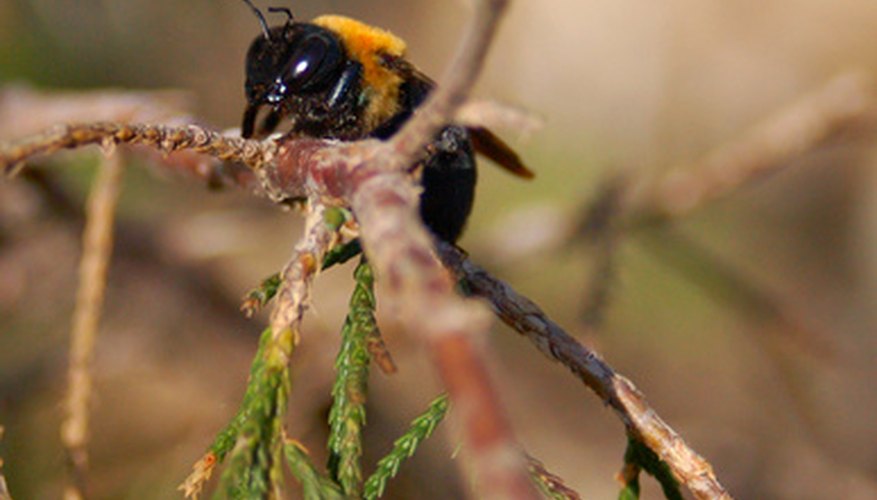Homeowners often notice large black and yellow bees flying under the eaves of their house. Wood bees, known as carpenter bees (Xylocopa virginica), construct their nests under the wooden eaves of buildings. The bees excavate large tunnels in the wood eaves where they seek shelter, a safe location to lay eggs and a place to raise their young. Many generations of wood bees will often inhabit one tunnel location, burrowing deeper into the wooden surface. The male and female spend the winter months in the tunnels. In the spring, the female lays her eggs in the cavern while the male works to guard the opening to the tunnel system.
- Homeowners often notice large black and yellow bees flying under the eaves of their house.
- In the spring, the female lays her eggs in the cavern while the male works to guard the opening to the tunnel system.
Locate the entrance to the wood bee's tunnel system. Look for a tiny hole or opening. During the day, the male wood bee will be active outside the tunnel.
Treat the wood bee tunnels in the evening after the sun has set. Both the male and female will be inside the tunnel when it is dark outside so both will be killed with the treatment.
Puff an insecticidal wood bee dust that contains at least 5 per cent carbaryl into the wood bee's tunnel entrance hole, according to the University of Kentucky Department of Entomology. Fill the handheld insecticide puffer duster three-quarters of the way full. Insert the nozzle of the handheld puffer into the hole and begin to puff the dust in.
- Treat the wood bee tunnels in the evening after the sun has set.
- Puff an insecticidal wood bee dust that contains at least 5 per cent carbaryl into the wood bee's tunnel entrance hole, according to the University of Kentucky Department of Entomology.
Dip cotton balls into a wood bee insecticide that contains permethrin or cyfluthrin. Thoroughly saturate the cotton ball with the substance.
Stuff the cotton ball into the opening to the wood bee tunnel using a pair of tweezers. Leave the cotton ball in the hole.
Watch the nest closely for any wood bee activity. If no activity is noted, the treatment was successful. If the bees remain active, treat the area again.
- Stuff the cotton ball into the opening to the wood bee tunnel using a pair of tweezers.
- Watch the nest closely for any wood bee activity.
Seal the wood bee hole using wood putty when there is no more bee activity. Ongoing generations of wood bees will often move into a treated wood bee hole, so monitor all areas closely.
TIP
The male wood bee cannot sting but the female wood bee is capable of stinging.
WARNING
Wear protective gloves when working with insecticides. Keep all insecticides out of the reach of children and pets.
